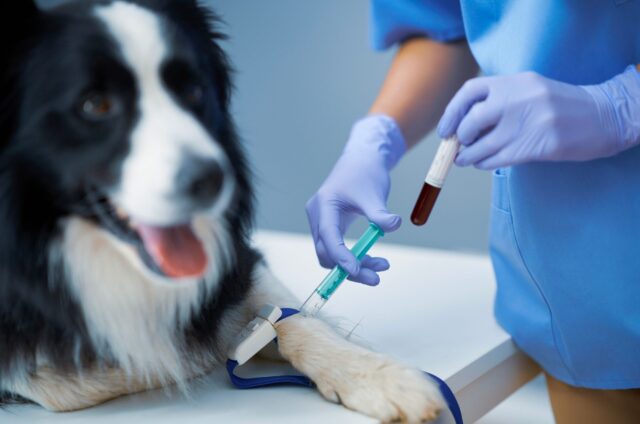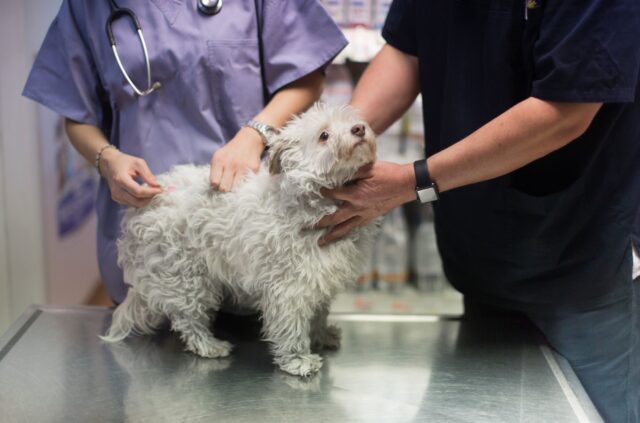Dog diabetes can be a frightening diagnosis, and up to 1% of domestic dogs will face it in their lifetime. Managing the disease can be complicated. However, with love and vigilance, you can ensure your diabetic dog lives a full, happy life.
The key to a positive outcome is twofold. First, it is essential to pick up on the signs and symptoms early, to prevent a life-threatening emergency. And second, careful monitoring and long-term treatment adjustments will help ensure your dog lives as long and as comfortably as possible.

Here you’ll find everything you need to know about the different types of dog diabetes, their signs and symptoms, and of course, how to monitor, treat, and manage the disease.
What is Dog Diabetes?
Is Diabetes a Serious Disease in Dogs?
Signs & Symptoms of Diabetes in Dogs
What Causes Diabetes in Dogs
Treating & Managing a Dog with Diabetes
Can Dog Diabetes Be Reversed?
What Are the Final Stages of Dog Diabetes?
What is Dog Diabetes?
As in humans and many other mammals, dog diabetes is a chronic disease in which the hormone insulin is either not produced in adequate amounts or not sufficiently utilized by the body. Although diabetes in dogs cannot be cured, it can be managed.
There are two types of diabetes seen in dogs, Diabetes mellitus and Diabetes insipidus, although the latter is quite rare. While believed to be underdiagnosed, Diabetes mellitus affects an estimated one in 300 dogs.
In this post, we will focus on Diabetes mellitus and the two forms it can take:
Insulin-Deficient Diabetes
This metabolic disorder is the most common type of diabetes mellitus in dogs. It occurs when the dog’s pancreas isn’t producing enough insulin due to illness or injury.
Insulin-Resistant Diabetes
Dogs with this type of diabetes have functioning pancreases that produce insulin, but their bodies are unable to utilize the hormone properly. This type of diabetes is most likely to occur in older, obese dogs. Female dogs may also develop temporary insulin resistance while pregnant or in heat.
The Importance of Glucose & Insulin
Every time your dog eats, carbohydrates and other nutrients are absorbed into the bloodstream as food passes through the digestive tract. Carbohydrates are converted into simple sugars such as glucose to fuel the body’s organs and tissues.
Without sufficient insulin, glucose cannot make the transfer from the bloodstream to the cells. Instead, it accumulates in high levels in the blood, causing a condition called hyperglycemia. The excess glucose overflows into your dog’s urine, drawing large amounts of water with it. This is why diabetic pets often urinate more frequently and seem incredibly thirsty.
Without enough glucose entering the cells, the body’s tissues become starved for energy. In an attempt to battle this metabolic “starvation,” the body breaks down stored fat and muscle tissue, which is then converted to sugar by the liver. This process accounts for the sudden weight loss and organ stress sometimes seen in diabetic patients.
Is Diabetes a Serious Disease in Dogs?
Whichever type of diabetes mellitus your dog suffers from, the negative effects on the body can be life-threatening. The bloodstream is flooded with excess sugar, yet the cells that need it to function cannot access it. This results in energy starvation, and the body starts breaking down fats and proteins as alternative fuel sources. High glucose levels in the blood can also cause organ damage by “poisoning” the kidneys, eyes, heart, blood vessels, and nerves.
The effects of uncontrolled diabetes on your dog’s health may include:
- Cataracts
- Enlarged liver
- Urinary tract infections
- Skin infections
- Seizures
- Kidney failure
- Ketoacidosis
Diabetic Ketoacidosis
Ketoacidosis is a potentially life-threatening condition that occurs when insulin levels drop dangerously low. The dog’s body begins to break down fat as fuel, which produces a buildup of acids in the bloodstream called ketones. This upsets the chemical balance of the blood and, if left untreated, can poison the body.
Risk Factors for Ketoacidosis:
Ketoacidosis is an acute condition that occurs in cases where diabetes is untreated or unregulated. It can be triggered by stress, surgery, fasting, infection, or an underlying health condition combined with a low insulin level.
Signs of Ketoacidosis in Dogs:
Dogs experiencing ketoacidosis may have rapid breathing, dehydration, lethargy, vomiting, or sweet/fruity-smelling breath.
If you have a dog with diabetes, keep ketone testing sticks on hand and test their urine if you notice any of these symptoms. A positive urine ketone test means your dog needs emergency veterinary care immediately.
Signs & Symptoms of Diabetes in Dogs
Dr. Michel Selmer, DVM, CTCVMP, spoke to iHeartDogs about some of the signs and symptoms of diabetes in dogs. Dr. Selmer is a Certified Veterinary Food Therapist (CVFT), something that comes in especially handy when treating his patients with diabetes.
In the words of Dr. Selmer, “If you’re worried that your dog may have diabetes, here are some major signs you should be on the lookout for:”
Increased Thirst:
Increased thirst and urination are often the first signs of dog diabetes. They occur because the dog’s body is trying to rid itself of excess glucose through the urine, which uses up a lot of water as it bonds to sugar molecules for disposal.
Increased Urination (amount and/or frequency):
You may notice that your dog has to go outside more frequently and produces larger amounts of urine. They may start having “accidents” in the house as the excess glucose in their body makes it harder for them to “hold it.”
Increased appetite:
As a primary source of energy, glucose is required for cells to function properly. When the supply is low, your dog may feel excessively hungry even though they are eating the same amount.
Weight Loss
Although many dogs are overweight when diagnosed with diabetes, you may notice weight loss along with increased hunger. This is because the dog’s body is unable to efficiently convert the nutrients from their food.
Dehydration
As noted above, glucose uses lots of water as it passes out of the body in your dog’s urine. Despite drinking large quantities of water, diabetic dogs are constantly losing hydration because they produce such dilute urine.
Cataracts
Diabetic dogs may develop cataracts due to an increase in the amount of glucose reaching the lenses of the eyes.
Dogs in more advanced stages of diabetes may show some of the following more serious signs and symptoms:
- Loss of appetite
- Lack of energy
- Depressed attitude
- Vomiting
According to Dr. Selmer, diabetes is just one of the “thirsty dog” diseases.
“If your dog is exhibiting any of the above signs, please see your veterinarian because they can have similar signs as dog diabetes,” he told iHeartDogs. “For instance, certain prescriptions cause excessive thirst. Specific urinary, kidney, and bladder conditions as well as other hormone-related diseases such as hypothyroidism and Cushing’s disease can also lead to excessive thirst.”
What Causes Dog Diabetes?
Age
While diabetes can occur at any age, middle-aged and senior dogs between four and 14 years are at the highest risk. Most diabetic dogs are diagnosed at roughly seven to 10 years of age.
Sex
Unspayed female dogs are twice as likely as male dogs to have diabetes.
Chronic Pancreatitis
Chronic or repeated pancreatitis (inflammation of the pancreas) can eventually cause extensive damage to the organ that produces insulin, resulting in diabetes.
Obesity
You may have heard that insulin resistance makes it difficult for overweight and obese people (and pets) to lose weight. Insulin resistance is when the cells no longer respond to insulin, causing blood sugar levels to increase. Unfortunately, insulin resistance can also contribute to pancreatitis, which in turn can lead to diabetes.
Steroid Use
Long-term steroid usage may cause insulin resistance, leading to obesity and steroid-induced diabetes. It is very important to use these drugs sparingly.
Cushing’s Disease
With Cushing’s disease, the body overproduces steroids internally, eventually causing dog diabetes.
Other Health Conditions
Some autoimmune disorders and viruses may also trigger diabetes.
Genetics
It is important to note that any breed or mixed-breed dog can develop diabetes, especially if there are health and lifestyle risks. A 2003 study found that mixed-breed dogs are no less likely to develop diabetes than purebreds. However, certain pure breeds do have a genetic predisposition for the disease.
Dog Breeds Prone to Diabetes:
- Cocker Spaniels
- Golden Retrievers
- Labrador Retrievers
- German Shepherds
- Dachshunds
- Dobermans
- Pomeranians
- Terriers
- Toy Poodles
- Bichon Frises
- Pugs
- Beagles
- Miniature Schnauzers
- Keeshonds
- Samoyeds
Treating & Managing a Dog With Diabetes
iHeartDogs asked Dr. Phil Baxter, Chief Veterinary Officer for Vet On Demand, to describe the most important things about managing dog diabetes.
“These points will increase your dog’s chances of having fewer issues and a higher quality of life for longer if you will apply them,” Dr. Baxter said. “Diabetes is a very difficult disease to control in dogs because it can constantly be changing. Good luck and good care with your dog!”
Diet
Your veterinarian will help you decide on the best type of food for your dog. Diabetic diets for dogs are usually low in fat and include high-quality protein, plus fiber and complex carbohydrates to help slow the absorption of glucose. Just as important as the type of food is the amount you feed. Be sure you ask your vet exactly how much your dog should be eating each day. Measure it out with a marked measuring cup and make sure all treats are accounted for and vet-approved.
Exercise
Moderate exercise keeps your dog’s body strong and helps avoid sudden spikes or drops in glucose levels. It also fights obesity, the enemy of the diabetic dog.
Regular Checkups
A diabetic dog should check in with the vet at least every six months as long as there are no issues. If any new symptoms or changes occur in your dog’s health, you should always err on the side of caution and seek veterinary attention.
Regular Labwork
Twice yearly CBC and Full Chemistry lab work is recommended for dogs with no issues. If your dog is having symptoms, you should be doing lab work even more often. These tests are necessary because diabetes can affect other organ systems.
Home Blood & Urine Tests
Glucose home monitoring will enable you to better regulate your dog’s insulin. Urine testing strips are also available so you can quickly check for the presence of ketones in the urine when your dog is feeling under the weather.
Rapid Care for ANY Sickness or Injury
Just as in people, diabetes affects overall health and healing. Addressing any medical issue promptly increases the chances of your dog recovering quickly and fully.
Insulin Injections
Most diabetic dogs will require daily shots of insulin under the skin. Although it’s understandable to be apprehensive about this, it’s not as hard as it sounds. Insulin needles are tiny. Most dogs can be easily distracted by a treat or a few vigorous pets during the injection. Soon, this step will become a quick and easy daily routine.
Symptom Monitoring
Be aware of your dog’s daily actions. Watch for changes in water consumption, urination, appetite, and weight, as well as changes in the appearance of the eyes (cloudiness or cataracts). Call your vet right away if you see any worrying signs or symptoms.
Know How to Recognize Hyperglycemia & Hypoglycemia
Hyperglycemia occurs when your dog’s glucose levels are too high. The signs are the same as the early stages of unregulated diabetes -drinking or urinating more than usual and/or increased appetite. If you begin to see these signs again after starting insulin therapy, it may mean the dosage needs to be altered. Hyperglycemia is not an emergency but can cause issues if left unregulated so contact your vet for instructions.
Hypoglycemia, on the other hand, is more serious. This occurs when the blood sugar level drops too low due to poor appetite or too much insulin. Symptoms include lethargy, sluggishness, stumbling, and tremors. Without emergency care, hypoglycemia can result in collapse, coma, and death.
Be Prepared for Emergencies
Keep testing strips on hand as well as Karo Syrup to help reverse a hypoglycemia episode. It is also important to develop an after-hours veterinary care plan. If your regular clinic does not offer on-call care on nights and weekends, make sure you know the location and phone number of the nearest emergency hospital.
Commitment
Most importantly, your pup is counting on you to be consistent, observant, and responsive to changes. This is the best way to keep your diabetic dog healthy and comfortable. The sooner you detect changes, the better.
Can Dog Diabetes Be Reversed?
Unfortunately, dog diabetes cannot be cured or reversed with diet and exercise as it may be in humans. Most diabetic dogs require insulin injections for life once diagnosed. Diabetic remission is possible but is more common in cats than in dogs.
However, addressing the underlying causes of diabetes, spaying female dogs, and treating Cushing’s disease and other contributing health conditions, can make diabetes easier to control.
What Are the Final Stages of Dog Diabetes?
Serious complications arise when blood sugar levels become difficult to regulate with insulin, diet, and exercise.
Ketoacidosis (discussed above) is often part of the final stages of dog diabetes.
“Advanced stages of diabetes will lead to profound weight loss and specifically muscle mass loss,” says Melanie Puchot, DVM, DACVIM, and board-certified veterinary internal medicine specialist at NorthStar VETS Veterinary, Emergency, Trauma, and Specialty Center. “They can become very weak as well from muscular and neurologic changes. Finally, they will develop the diabetic ketoacidosis complication which will lead to vomiting, diarrhea, lethargy, and decreased appetite,” Puchot explains.
How Do You Know if Your Diabetic Dog is Dying?
The signs listed above:
- Extreme weight loss
- Loss of muscle mass
- Weakness
- Lethargy
- Neurological changes
- Vomiting
- Diarrhea
- Loss of appetite
along with unregulated blood sugar, tremors, seizures, and abnormal breathing could be signs your dog with diabetes is dying.
However, with excellent veterinary care, thorough monitoring, and attention to detail, there is no reason to believe your diabetic dog cannot enjoy many happy years by your side!









 Toledo, United States.
Toledo, United States.